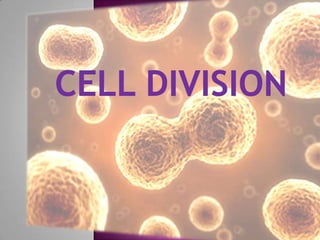Cell division
- 2. ÔÇû Theprocess by which a cell divides into two or more cells. ÔÇû Cell division is also the source of tissue growth and repair in multicellular organisms
- 3. ÔÇûS¥«≥æ≤π≥Ÿæ±≥¶ cell ÔÇûSex cell
- 4. ÔÇûReplacing dying especially in the epidermis where the requirement is continuous. ÔÇûRepairing the damage, mostly when the body has faced the onslaught of trauma and disease.
- 5. ÔÇû Refers to all body ÔÇû Contain diploid (2n) cell except the sex number of cell. chromosomes . ÔÇû Skin cell, muscle ÔÇû somatic cells contain 46 cell, nerve cell, chromosomes or 23 bone cell, stomach homologous pairs of cell and liver cell. chromosomes. ÔÇû Multicellular organisms use mitosis for growth, cell repair, and cell replacement.
- 7. ‚Ä¢P≥‹∞˘±Ë¥«≤ı± of mitosis is replication of somatic cells and asexual reproduction ‚Ä¢Mitosis is the division of chromosomes in a cell ‚Ä¢Usually followed by cytokinesis or cell division
- 8. •Refers to the  egg cell  Sperm cell gametes, the sperm cell of male and egg cell of the female
- 9. ÔÇû Sex cells only contain 23 chromosomes and are called haploid. ÔÇû These cells have half the amount that a normal non-sex cell would have. ÔÇû So when they divide only 23 chromosomes are given to the new cell.
- 10. After these sex cells combine and fertilization occurs the resulting cell that is formed is called a zygote As soon as the zygote is formed, it then begins to go through cell division.
- 11. During Meiosis gamete (sex) cells undergo a “double division”, maintaining the DNA, but reducing the chromosomal count to 23 Sperm (23) + Egg (23) = Fertilized Cell(46)
- 13. ÔÇû Autosomes Contain genetic information for most human characteristics, such as eye color, hair color, height, and skin pigmentation Sex Chromosomes Primarily determines whether an individual is female (2 X chromosomes) or a male (1 X and 1 Y chromosomes)
- 14.  Somatic cell  Sex cell Is any cell that is  Refers to gametes non reproductive the egg cell and cell. sperm cell  Contain 46  Contain 23 (n) of chromosomes or chromosomes 23 homologues  Undergo mitosis pair of and meiosis chromosomes  Undergo mitosis
- 15. 1. Mitosis produces 2 daughter cells that are genetically identical to the parent cell. Meiosis produces 4 daughter cells that are genetically different from the parent cell. 2. Mitosis produces diploid (2n) daughter cells. Meiosis produces haploid (n) daughter cells. 3. In meiosis, a process called crossing over occurs, whereby genetic material is exchanged b/w homologous chromosomes.















